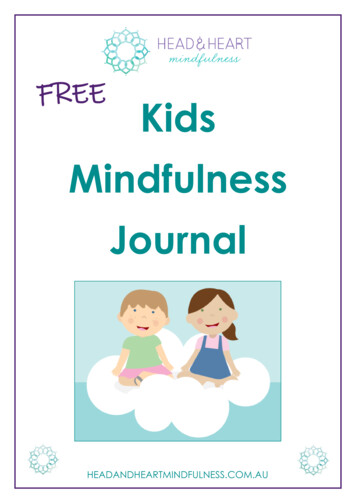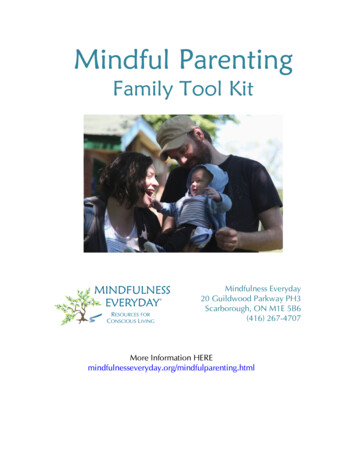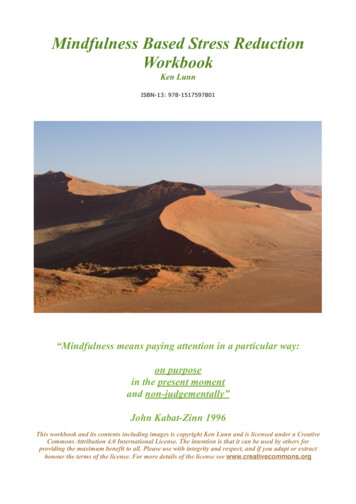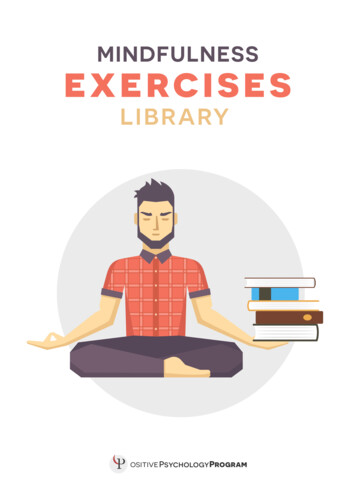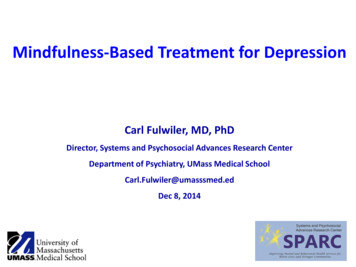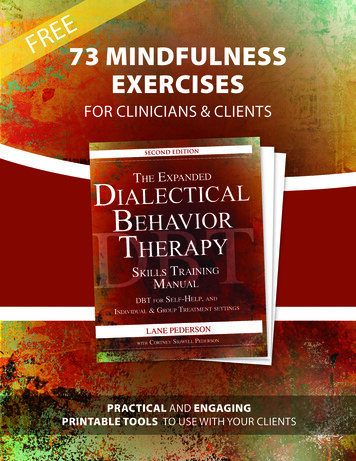
Transcription
Treating Adolescent Trauma with MindfulnessUSC-ATTC WebinarTreating Adolescent Traumawith MindfulnessRandye J. Semple, PhDUniversity of Southern CaliforniaAdolescent Trauma Training CenterLos Angeles, CAattc.usc.eduDisclosures The University of Southern California—AdolescentTrauma Training Center (USC-ATTC) is funded bySAMHSA grant #1U79SM061262-01 as a Category IITreatment & Service Adaptation (TSA) Center of theNational Child Traumatic Stress Network (NCTSN) Dr. Semple has no conflicts of interest to discloseLearning objectives Describe the mindfulness component of ITCT-A asit was adapted for use with adolescents Articulate clinical issues & contraindications toconsider before using mindfulness-basedinterventions to treat traumatized adolescents Explain the personal benefits of mindfulness fortherapists who work with traumatized teensSeptember 27, 20171
Treating Adolescent Trauma with MindfulnessUSC-ATTC WebinarRoadmap What mindfulness is & what it isn’t Mindfulness in ITCT-A Treating trauma with icalBehavioral Teaching mindfulness Summary & take-home pointsRoadmap What mindfulness is & what it isn’t Mindfulness in ITCT-A Treating trauma with icalBehavioral Teaching mindfulness Summary & take-home points“The faculty of voluntarilybringing back a wanderingattention, over and overagain, is the very root ofjudgment, character,and will.”“But it is easier to definethis ideal than to givepractical directions forbringing it about.”William James (1890)September 27, 20172
Treating Adolescent Trauma with MindfulnessUSC-ATTC Webinar“Mindfulness means paying attentionto things as they are in any givenmoment, however they are, ratherthan as we want them to be.”Williams, Teasdale, Segal & Kabat-Zinn (2007)Components of tSkillful choicesComponents of tSeptember 27, 2017Skillful choices3
Treating Adolescent Trauma with MindfulnessUSC-ATTC WebinarComponents of tSkillful choicesComponents of tSkillful choices“It is remarkable howliberating it feels tobe able to see thatyour thoughts arejust thoughts andthat they are not‘you’ or ‘reality’.”Kabat-Zinn (1990)September 27, 20174
Treating Adolescent Trauma with MindfulnessRedirect attentionto the breathFocus attention onthe breathAcknowledgecurrent focus ofattentionAttentionwanders from thebreathUSC-ATTC WebinarMindful breathing Sit with straight back & hands in the lap Closed eyes (or a “soft” unfocused gaze) Bring attention to the experience of breathing When you become aware that mind has wandered,simply note the thoughts & feelings Then, return attention to watching the breathWhat mindfulness is not September 27, 2017Turning off thoughtsEmptying the mindAn escape from realityPassive or complacentMagical or mysticalHypnotic or addictiveSelf-indulgentReligionA quick fix5
Treating Adolescent Trauma with MindfulnessUSC-ATTC WebinarLiving.Every.Moment.Roadmap What mindfulness is & what it isn’t Mindfulness in ITCT-A Treating trauma with icalBehavioral Teaching mindfulness Summary & take-home pointsIntegrative Treatment of Complex Trauma for AdolescentsITCT-A Multiply traumatized, socially marginalized teens Culturally sensitive Flexible time-frame individualized for each client Regular assessments Early attention to safety issues Titrated therapeutic exposure Skills development & problem-solving Systems-level advocacySeptember 27, 20176
Treating Adolescent Trauma with MindfulnessUSC-ATTC WebinarMindfulness in ITCT-A Optional module Therapist training & experience is recommended Simple mindful awareness activities can be taughtwith minimal training Benefits to being a mindful therapist Refer to a qualified mindfulness program for moreextensive trainingApplications Stress managementAnxietyDepressionPhysical tensionPain managementEmotion self-regulationBehavioral self-management(e.g., anger management, eating disorders,alcohol/substance abuse relapse prevention)Contraindications Ongoing traumatic environment Chronically overwhelmed Current alcohol/substance abuse Mania Severe anxieties Severe depression Suicidality PsychosisSeptember 27, 20177
Treating Adolescent Trauma with MindfulnessUSC-ATTC WebinarAvailable youth programs Inward Bound Mindfulness Education (iBme)Stressed Teens (MBSR-T)A Still Quiet PlaceLearning to BREATHEMindfulness-based Cognitive Therapy for Children (MBCT-C)Mindfulness for Teens (MBCT-A)Connecting Adolescents to Learning Mindfulness (CALM)Making Friends with Yourself (MSC for children & teens)Mindfulness-based Eating Awareness Training (MB-EAT)Mindfulness-based Relapse Prevention (MBRP)Roadmap What mindfulness is & what it isn’t Mindfulness in ITCT-A Treating trauma with icalBehavioral Teaching mindfulness Summary & take-home pointsInhale.Exhale.Repeat.September 27, 20178
Treating Adolescent Trauma with MindfulnessUSC-ATTC WebinarTraumatic stress“Perceived demands are greater thanthe individual’s perceived coping resources” Stress responses occur in 4 BehavioralSeptember 27, 20179
Treating Adolescent Trauma with MindfulnessMetacognitiveawarenessUSC-ATTC WebinarDissociation Looks towardthoughts & feelings Looks away fromthoughts & feelings Aware of bodysensations Numb to bodysensations Feels connectedwith self & others Feels disconnectedfrom self & others Attuned to environment Unaware of environmentBoth can be protective coping strategiesMindfulness of thoughts Trauma increases past & future-focused thinking Mindfulness cultivates present-focused attention Observing thoughts flow by Increased clarity of seeing Thoughts become simply events in the mind Not facts Not real Not current Not me Not true Just thoughtsMindfulness of emotions Explore & identify emotions (detective work)– Attend to emotional experiences– Observe without clinging or pushing away– Reduce identification (“just” emotions, not facts) Practice non-judgment & acceptance– Befriend emotions (sitting with distress)– Enhance self-compassion & empathySeptember 27, 201710
Treating Adolescent Trauma with MindfulnessUSC-ATTC WebinarYou can’t stop the waves,but you can learn to surf.Joseph GoldsteinMindfulness of body sensations Body awareness– “body scan” techniques Mindful movement– yoga, t’ai chi, stretching Grounding techniques– “soles of the feet” walking meditation Relaxation– breath counting, “letting go” techniquesMindfulness in everyday life Practice a few minutes of mindful awareness– Before doing homework– Doing household tasks– Brushing teeth– Washing hands– Eating meals– Listening to music– WalkingSeptember 27, 201711
Treating Adolescent Trauma with MindfulnessUSC-ATTC WebinarRoadmap What mindfulness is & what it isn’t Mindfulness in ITCT-A Treating trauma with icalBehavioral Teaching mindfulness Summary & take-home pointsEmbodying mindfulness Attend to your own practice– Ground your teaching in your own experience– Share your own experiences Model mindfulness in your speech & actions– Practice compassionate acceptance– Foster authenticity, mutual respect & connectionWhy bother? Being present Seeing clearly––––ThoughtsEmotionsBody sensationsCircumstances Making skillful choices Acting with intention & awarenessSeptember 27, 201712
Treating Adolescent Trauma with MindfulnessUSC-ATTC WebinarMake it meaningful Make it relevant to what’s happening in their world Invoke suitable role models (celebrities, athletes) What’s in it for them?– Less worry– Better physical & mental health– Improve relationships with family or peers– Better performance (academically or in sports)Practice tips Start with short, simple practices Approximately 1 minute per year of age Avoid reading scripts or instructions Offer encouragement Invite participation (emphasize freedom to choose) Practice together Attend to your own practiceThere’s an app for that“Meditation is the ultimatemobile device. You can useit anywhere, anytime,unobtrusively.”iPhoneSharon Salzberg (2011)MindShiftSmiling MindThe Mindfulness AppStop, Breathe, and ThinkSeptember 27, 2017AndroidHeadspaceInsight TimerMindfulness BellMeditation Helper13
Treating Adolescent Trauma with MindfulnessUSC-ATTC WebinarRoadmap What mindfulness is & what it isn’t Mindfulness in ITCT-A Treating trauma with icalBehavioral Teaching mindfulness Summary & take-home pointsCultivating mindfulness(for our clients & for ourselves) Mindfulness promotes changes– Metacognitive awareness– Acceptance, self-compassion & empathy– Equanimity Offers opportunities– See clearly– Recognize choices– Choose adaptive responsesTake-home points1. Mindfulness is attention– Present-focused, non-judgmental, accepting– Reduces past & future-oriented thinking2. Practicing mindfulness is not difficult– Remembering to practice is hard3. We don’t need to believe everything we think– Choices exist in the present moment– Choices create freedomSeptember 27, 201714
Treating Adolescent Trauma with MindfulnessUSC-ATTC Webinar“If every 8 year oldin the world istaught meditation,we will eliminateviolence from theworld within onegeneration.”HH the XIV Dalai LamaSeptember 27, 201715
Sep 27, 2017 · Therapist training &experience is recommended Simple mindful awareness activities can be taught with minimal training Benefits to being a mindful therapist Refer to a qualified mindfulness program for more extensive training Applications Stress management Anxiety Depression Physical tensi
